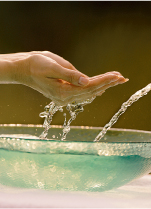Soothing hydrotherapy
Hydrotherapy is the use of water at different temperatures to revitalize, maintain, and restore health. It is an effective therapy for many ailments, including colds and flu.

+ Ancient Greeks and Roman used sources of water for their healing properties, but later the practice was lost. By the 18th and 19th centuries, the method of using water therapeutically was readopted and introduced as a medical treatment. Hydrotherapy is used to stimulate our bodies’ internal activity, which helps our bodies’ immune systems, but also in the prevention and treatment of illnesses.
Common hydrotherapy techniques are:
- • Soaking and rubbing, that may increase blood circulation and regulate breathing.
- • Hot and cold compresses, may help to lower fevers and to stimulate blood flow.
- • Cold Showers and cold baths, may stimulate the circulatory and nervous systems.
- • Hot showers and hot baths may help you to relax.
- • Shower streams aimed at a specific affected part of the body.
- • Sauna and steam baths, which may help to relieve congestion.
IMMEDIATE REFLIEF
There are specific hydrotherapy treatments for congestion and chills that also may help to release toxins in the body and reduce your susceptibility to illnesses.
Prevention
- • Taking a cold bath for 10 minutes may help your immune system to prevent colds and to increase your energy, only if you are accustomed to taking cold baths. When you get out of the bath tub, its best to exercise or rest covered up, cozy in bed.
- • The healing therapies of water can be intensified by adding cider vinegar or sea salts (calculate 1 cup of vinegar per bathtub, or 2 teaspoons of sea salt for every 33 fl oz/1 liter of water).
For cases of colds and fevers
- • With the first signs of a cold, it may be helpful to soak in a warm bath (it's best to stay in the bathtub no longer than 20 minutes). Compresses moistened with cold water are very good for lowering fevers, especially for children. Place a compress on the forehead and change it every 10 minutes or whenever the linen cloth begins to warm up. You can also use compresses on other parts of the body, such as the underarms, chest and behind the knees.
- • In the case of a high fever, doctors may recommend a lukewarm bath. When you get out it's important to cover up with a dry towel and then go to bed, covered up.
- • For congested respiratory tracts steam baths can be very effective. Close the bath room door, turn on the faucet for hot water and wait until the bathroom fills up with steam. Stay in the steam bathroom for at least 5 minutes. This treatment may be very useful for relieving children when they are fighting against a stuffed up nose.
ANTI-FEVER HYDRATION
Drinking a lot of fresh water at room temperature and lukewarm teas can be good for fevers and for fighting colds and infections such as angina.

WATER AND SALT GARGLE
Gargling with salt water can work as a great remedy to relieve a sore throat. To prepare, add 1 teaspoon of salt to 1 glass of lukewarm water.

Comment about this article, ask questions, or add new information about this topic: